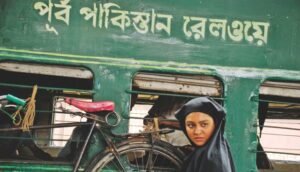Across the country, arrival of the film “Guerrilla” corresponded with the Bengali New Year (2011) and this was done which is all well and good. “Guerrilla” portrays the story of Bilkis, played by Joya Ahsan, a political dissident, who effectively takes an interest in the Liberation War while looking for her lost spouse. In light of Syed Shamsul Haque’s tale Nishiddho Loban 1981, the film likewise includes components from its director Nasiruddin Yousuff’s self-encounters, during the war.

At first, the reason appears to be sufficiently basic; Bilkis’ husband, Hasan Ahmed, played by Ferdous who is a calling columnist, disappears as the war breaks out. Clutching the conviction that her husband is as yet alive Bilkis scours each spot for him while effectively partaking in the furnished obstruction and proceeding with the distribution of the magazine Guerrilla which represents the political dissidents.
Where quite a few movies based on the Liberation War have not worked, Guerrilla succeeds, as it remarkably infuses fiction with reality. This is the most evident by Ahmed Rubel’s portrayal of Shaheed Altaf Mahmud, composer of “Amar Bhai-er Rokte Rangano Ekushey February”. Although briefly, Altaf’s dedication to his country as he continues to unearth gems of Bengali literature in a bid to preserve them and warily refuses to compose Urdu songs despite the immense pressure. While Bilkis plans with Altaf, the hauntingly beautiful tunes created by the composer plays in the background, moving the audience to a contradictory reverie of calm and despair.

There are different characters whose structure is a fundamental piece of the film. Shatabdi Wadud, ATM Shamsuzzaman, and Pijush Bandyopadhaya, among others, complete their jobs convincingly, captivating the crowd. Wadud merits uncommon acclaim for his depiction of a Pakistani major. Having nearly consummated the emphasis, the entertainer presents a cardboard figure of the unfeeling, hard-drinking, and womanizing Pakistani major. He advances from an entertainer into a persona we as a whole love to detest.
In the film, we see Bilkis getting involved with the development, while keep watching out for any updates on her husband and take care of her ill mother-in-law who noticed Bilkis’s faults to the Hasan disappearance till her final gasp. As the two powers, the Pakistani armed forces and the freedom fighters, assassinate one another, the constrain increments to control further harms. Taslim Sardar, tried by ATM Shamsuzzaman, at one point turns into Bilkis’ sole defender, helping her to escape as the occupation powers are cautioned of her association. A huge man-chase results and Bilkis some way or another figures out how to avoid, selecting her old neighborhood as an asylum.
Her brother, additionally a freedom fighter, is her last thrust in the asylum. She surrenders the quest for her better half briefly and starts searching for her brother. As Bilkis circumspectively moves towards conceivably the last relative she has left, a looming feeling of fiasco develops. The Pakistani armed forces promises to chase down Bilkis’ brother and his comrades. Bilkis’s arrival home is covered with recollections of an upbeat yesterday, yet the natural boulevards of her old neighborhood appear to be strange to her. Death welcomes her; she resists and continues to move forth, determined, disgusted, disturbed yet undeterred.

From my point of view, this film shows the brutalities unleashed by the Pakistani army and their collaborators rather explicitly thus do not hold back on gore and blood. Slaughter of men, rapes, torture, and extreme humiliation all surface continuously. Although the random acts of intolerable violence might seem unreal to post-war generations, the filmmaker wants them to know this was the price the nation had to pay for freedom. At one point the story seems to be lost as the protagonist loses her way, but then another side of the war is revealed, that which was being fought outside the cities.
I can clearly remember the scene from the train, where Pakistani militants were hatching a young woman from the train, one Muslim civilian was actively supported the militants. This shows the religious conflicts in the Indian sub-continent. Syed Shamsul Haque wrote it in 1981 but still in this period we continuously get the experience of these religious conflicts directly or passively.
This movie should appeal to a younger demographic, those who have not seen the war, as they get to see just how deep-rooted the freedom movement was — people from all walks of life uniting to free the country.
Joya’s performance holds the movie together, even when the plot changes. This is yet another feather in the cap for the accomplished actor. “Guerrilla” is indeed a must-see, especially for those who are yet to face the grave realities of a period that defines our history; a history that is brutal yet tragically inspiring.
The images have been collected from different sources available on the internet.










